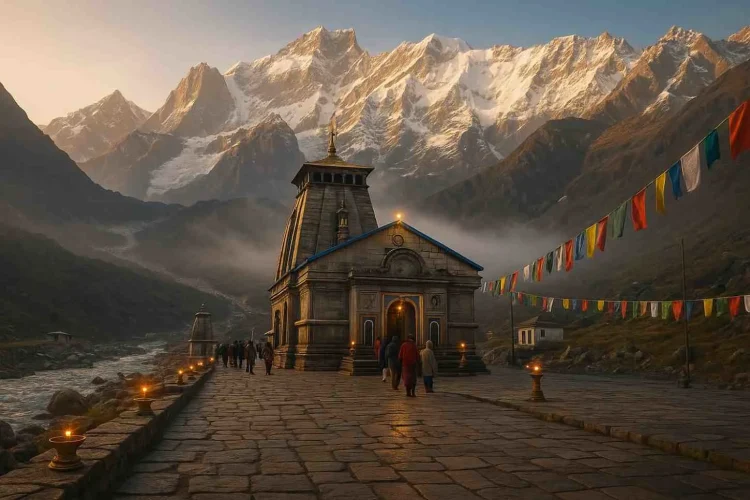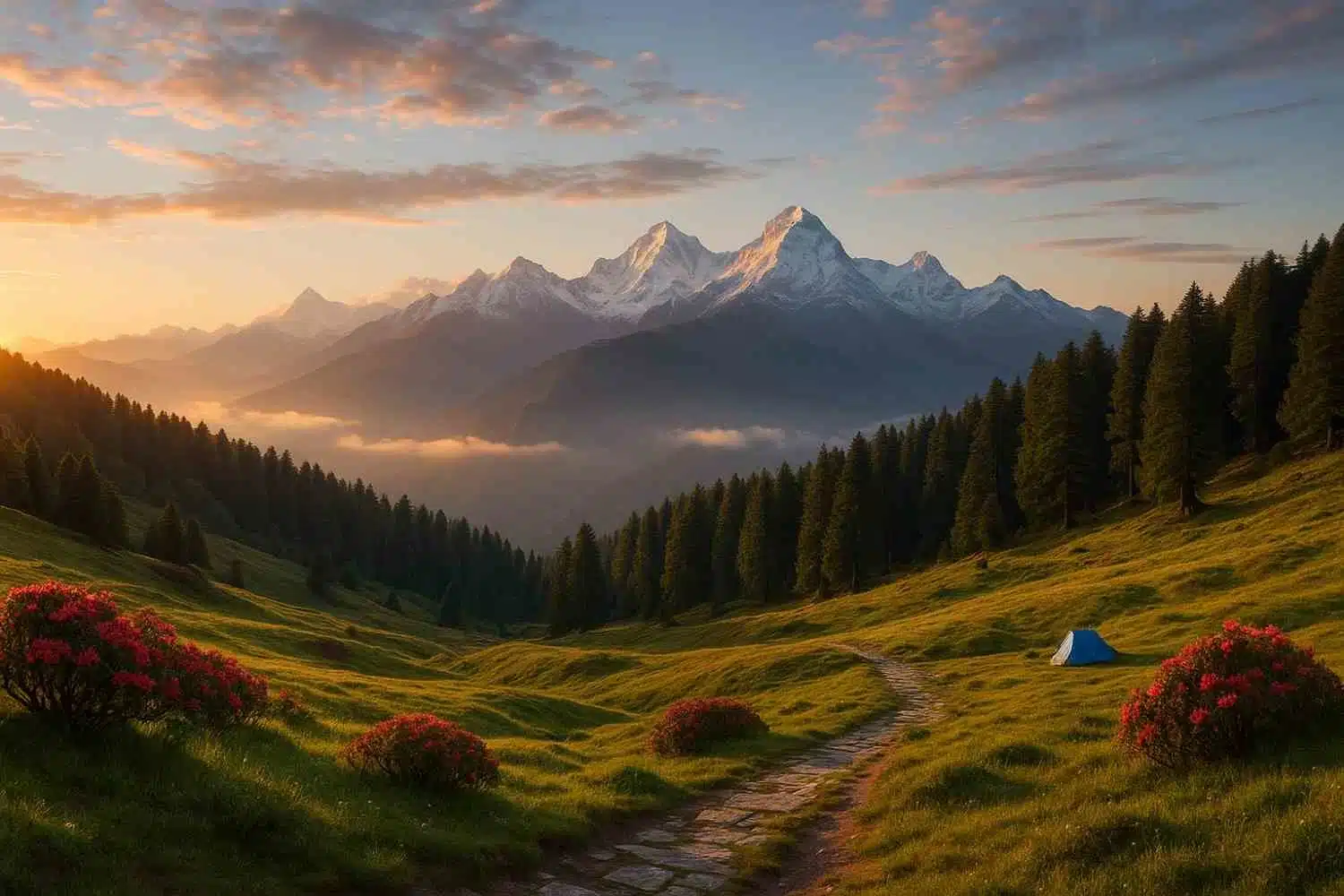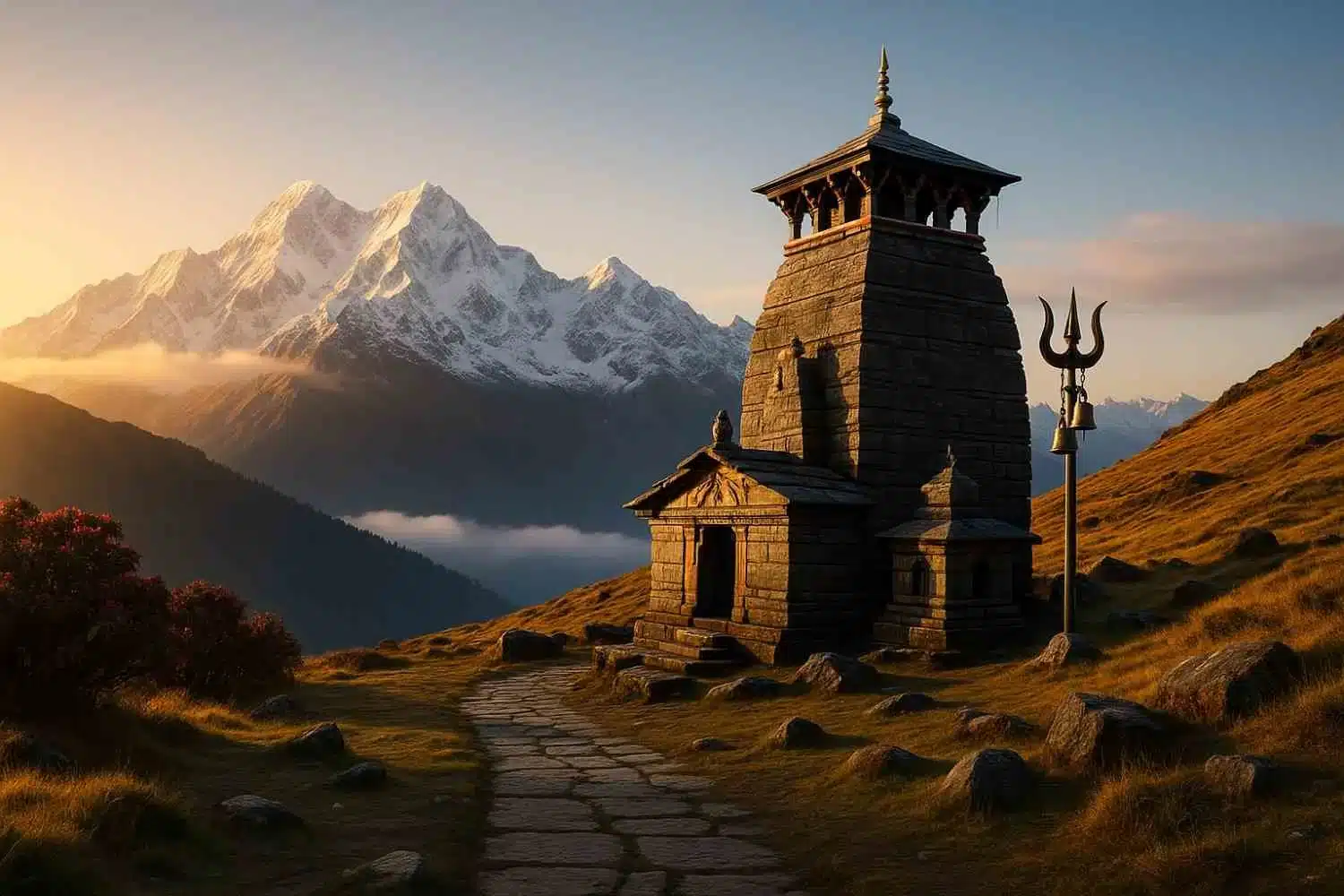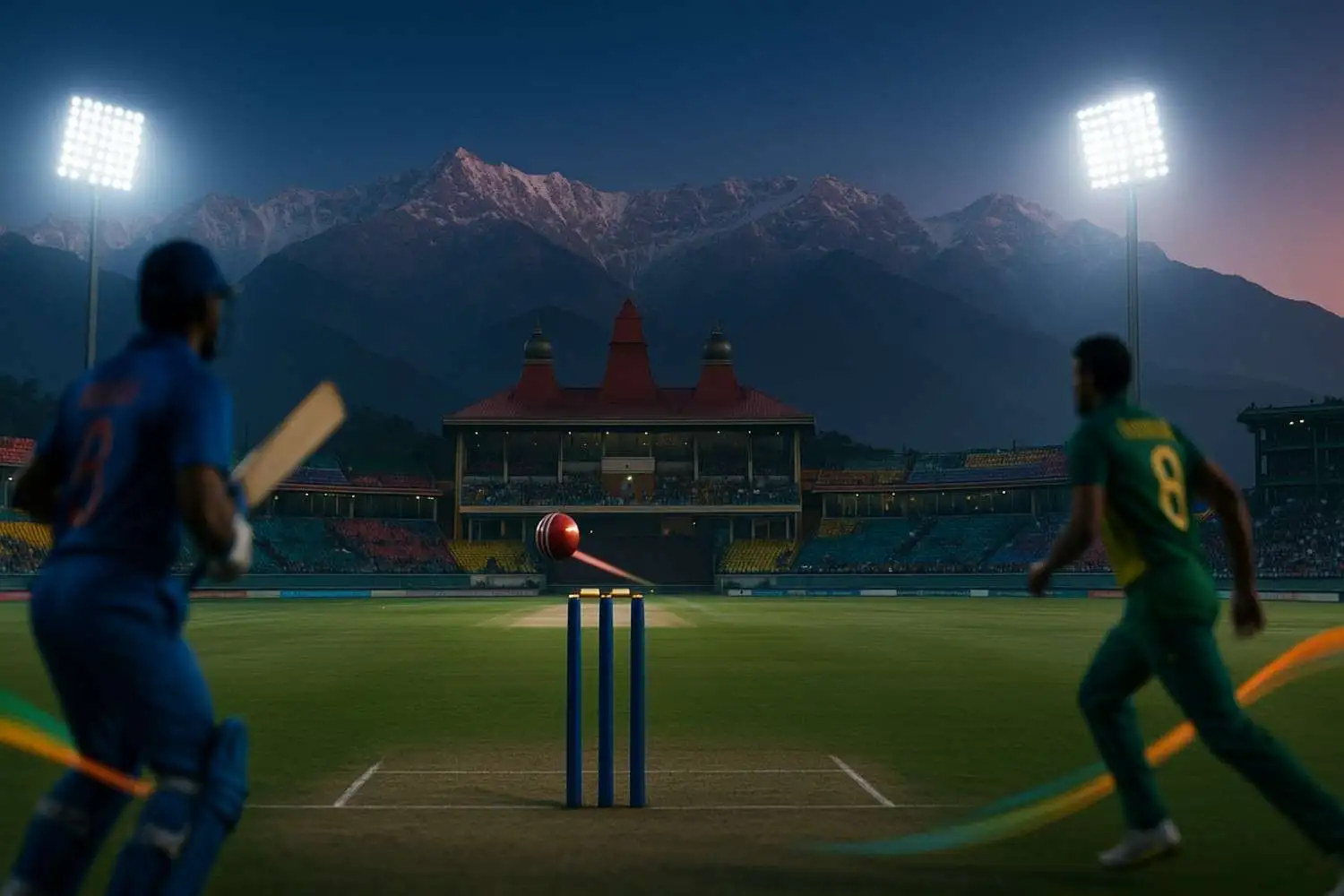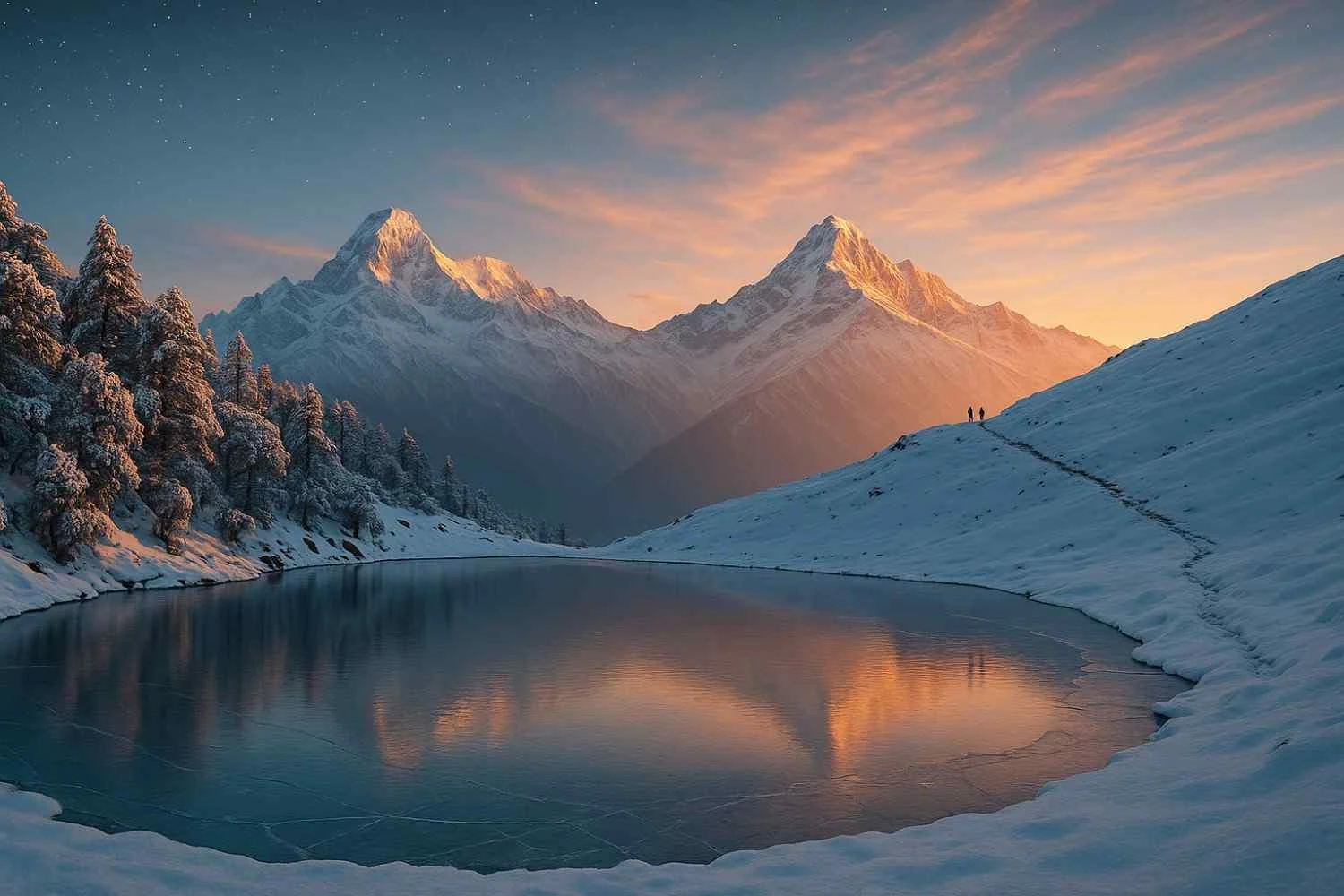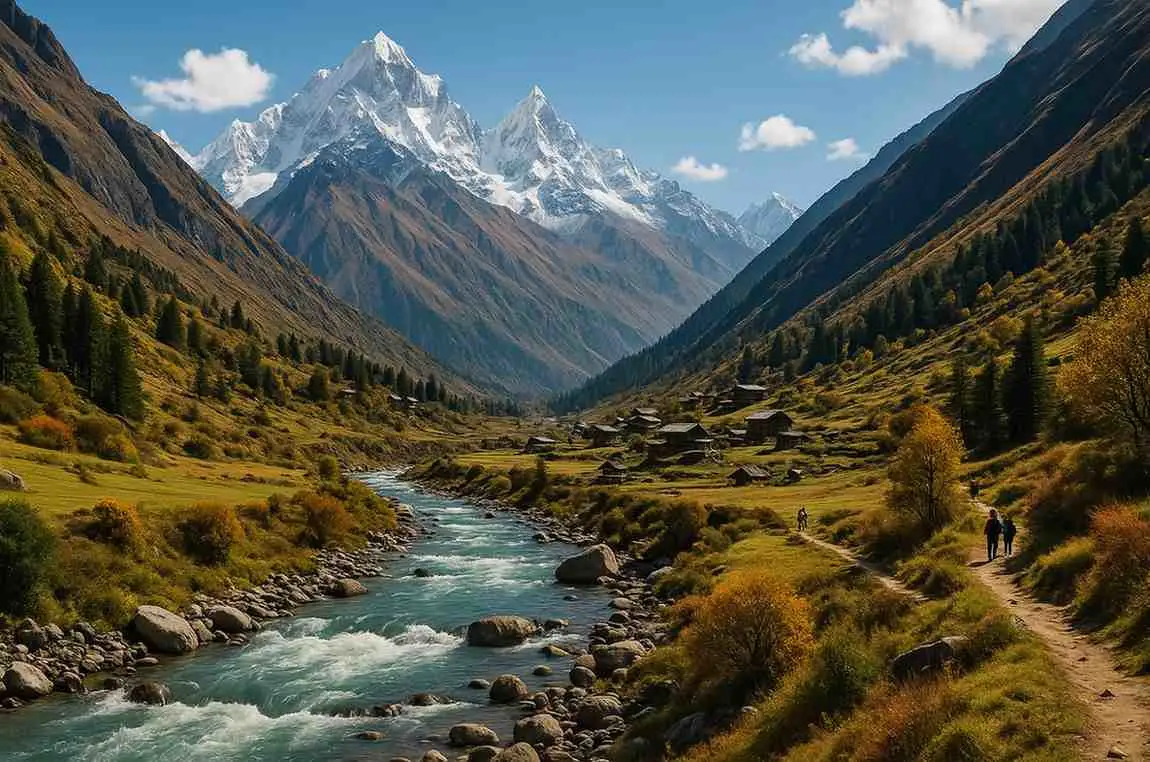Kedarnath isn’t just a dot on a Himalayan map. It’s one of the holiest Shaivite shrines in India, tucked high in the Garhwal Himalayas, where every prayer seems to ride the wind and vanish into snow peaks. Pilgrims come for darshan of Lord Shiva as “Kedar,” but they also come for something harder to define—quiet strength, a reset, proof that effort and faith still matter. This guide collects everything you need: a concise history, when the temple opens and closes each year, the trek from Gaurikund, helicopter options, darshan and aarti timings, places to visit nearby, where to stay, and practical tips that actually help on the mountain.
About Kedarnath Temple
1. Why is Kedarnath one of the 12 Jyotirlingas
Kedarnath is revered as one of the twelve Jyotirlingas—sacred abodes where Shiva is said to have manifested as a pillar of divine light. Pilgrims believe darshan at Kedarnath grants liberation from the bonds of the past and the courage to face what comes next. Among the Char Dham (Yamunotri, Gangotri, Kedarnath, and Badrinath) of Uttarakhand, Kedarnath stands out for its stark, stone serenity and the effort it demands: the path itself becomes a part of the prayer.
2. Location in the Garhwal Himalayas
The temple sits in the Rudraprayag district of Uttarakhand, on a raised stone plinth near the headwaters of the Mandakini River. The settlement around it is compact—simple lodges, dharamshalas, the helipad, GMVN facilities, a few shops—and then, very suddenly, the wild.
3. River Mandakini’s significance
The Mandakini, a tributary of the Alaknanda, flows down from the Chorabari Glacier region. To pilgrims, the river is a purifier and a guide. You trace its course from Sonprayag to Gaurikund to the main trail, and its music never quite leaves your ears the whole way up.
4. Altitude and surrounding peaks
Kedarnath Temple stands at roughly 3,583 meters (11,755 feet). Behind it rises the Kedarnath massif; high on clear days, you see white ridges stacked like the pages of a book—snow, ice, shadow. The altitude is part of the experience: thinner air, colder nights, sharper stars.
Kedarnath Opening & Closing Dates
Kedarnath follows a strict Himalayan calendar. The temple’s kapaat (doors) open in late April or early May—on or near Akshaya Tritiya—after priests bring the sacred idol of Lord Kedarnath from its winter seat in Ukhimath. The closing ceremony takes place around Bhai Dooj (two days after Diwali), when the idol begins its return journey to Ukhimath’s Omkareshwar Temple for the winter.
1. Kapaat opening ceremony & timings
On opening day, the first Abhishek is performed in the early morning, and the temple remains open through the day for darshan on a staggered schedule. If you want a calmer experience, arrive a few days after the opening; the first 2–3 days can be very crowded.
2. Winter closure and Ukhimath
Once the kapaat closes (typically in October/November), the deity is ceremonially shifted to Omkareshwar Temple at Ukhimath, where worship continues through winter. Devotees who wish to offer prayers “to Kedarnath in winter” do so at Ukhimath.
3. Best month for darshan
There’s no single “best” month, but here’s a practical take:
- May–June: Clearer skies early on, snow patches receding, cold mornings, heavy pilgrim flow.
- July–August: Monsoon brings rain and landslide risk; not recommended unless you’re monitoring the weather daily.
- September: Post-monsoon clarity with fewer crowds—arguably the sweet spot.
- Early–Mid October: Crisp, cold, often bluebird mornings; nights are freezing, but crowd levels are manageable.
Monthly Snapshot: Weather, Advisory, Temple Status
| Month | Temperature (approx.) | Weather feel | Travel advisory | Temple status |
| Late Apr | 0–10°C | Very cold mornings, snow in patches | Warm layers + waterproofs | Opens (Akshaya Tritiya period |
| May | 2–12°C | Cold nights, sunny days | Heavy footfall; book early | Open |
| Jun | 5–14°C | Pleasant days, chilly nights | Afternoon cloud buildup; start early | Open |
| Jul | 6–12°C | Wet, foggy | Monsoon: landslides, delays | Open (subject to weather) |
| Aug | 6–12°C | Wet, low visibility | Avoid unless essential | Open (subject to weather) |
| Sep | 2–10°C | Clear, crisp | Post-monsoon—great trekking | Open |
| Early Oct | -2–8°C | Cold, bright | Pack down jacket; shorter days | Open |
| Nov–Mar | Sub-zero | Snowbound | Not trek season | Closed (idol at Ukhimath) |
Temperatures swing with storms and altitude. Always check the latest advisory before travel.
History & Legends of Kedarnath
1. Pandavas and the Mahabharata
According to legend, after the Kurukshetra war, the Pandavas sought penance for the bloodshed. They came searching for Shiva in the Himalayas. Shiva, wishing to avoid them, disguised himself as a bull and roamed these valleys.
2. Bhim and the Bull
Bhim recognized the bull and tried to seize it. The bull dived into the earth, and different parts of Shiva’s form manifested at five places now called the Panch Kedar: Kedarnath (hump), Tungnath (arms), Rudranath (face), Madhyamaheshwar (navel), and Kalpeshwar (hair). Kedarnath, the “hump,” became the chief shrine—its linga shaped like a natural, irregular stone that devotees believe holds the mountain’s own heartbeat.
3. Adi Shankaracharya
In the 8th century, Adi Shankaracharya is said to have re-established the shrine and codified worship here, strengthening the Char Dham tradition. A memorial near the temple complex reminds visitors of his role in restoring pilgrimage routes that knit together the spiritual geography of the Himalayas
How to Reach Kedarnath Temple
Reaching Kedarnath is part logistics, part adventure. You’ll likely come through Haridwar or Rishikesh, push to Sonprayag, overnight at Gaurikund, and then tackle the main trail. If trekking isn’t possible, helicopter services run from nearby helipads, weather permitting.
1. By Road
- Haridwar/Rishikesh → Sonprayag: Regular buses and shared jeeps run in season. Private cabs are common. The route follows the Ganga and then the Alaknanda/Mandakini valleys, passing Srinagar, Rudraprayag, and Guptkashi.
- Sonprayag → Gaurikund: Local shuttle jeeps ferry pilgrims on the last stretch; private vehicles usually stop at Sonprayag parking.
- Road conditions vary with the weather. Start at dawn to hit Sonprayag by late afternoon, especially on holidays.
2. By Trek
Classic route: Sonprayag → (shuttle) → Gaurikund → Kedarnath
- Distance: ~16–18 km from Gaurikund to the temple, depending on the final route in use that season.
- Trail character: Paved in long sections, with steep grades, multiple bends, and frequent chai-and-maggi stalls. Cool mornings, strong sun later, and the odd blast of katabatic wind.
- Trek difficulty: Moderate to challenging due to elevation gain and altitude. Fit beginners can do it with rest and a steady pace; those with cardiac, respiratory, or knee issues should consult a doctor and consider a pony/palki or helicopter.
- Duration: 6–9 hours for most trekkers, excluding long rests. Many start before sunrise from Gaurikund to reach before the afternoon clouds.
3. Pony, palki, and porter
- Ponies (khacchar): Useful for those with knee trouble; rates are posted at the base. Expect dynamic pricing by season; negotiate only within the official band and insist on a slip/receipt.
- Palki/doli: Carried by trained porters, suitable for senior citizens or those unable to sit on ponies.
- Porters (pitthu): For bags and daypacks, so you can walk lighter.
Always choose registered operators, weigh limits, and keep phone numbers on the receipt. Carry small notes for tea and quick snacks.
4. Trail etiquette and safety
- Keep right; give way to ponies and palkis.
- Stay hydrated, but sip—not gulp—to avoid nausea.
- Don’t rush the last 3–4 km; altitude catches many pilgrims there.
- Headlamp for early starts, rain protection handy at all times.
5. By Helicopter
When walking isn’t feasible, helicopters operate short shuttles to the Kedarnath helipad (a short walk to the temple).
- Helipad points: Phata, Guptkashi, and Sirsi are the most used bases.
- How it works: You book a specific date/time slot with a listed operator. On the day, arrive 60–90 minutes early for check-in and weight/baggage screening. Weather dictates everything, so delays or cancellations are common.
- Tickets and ID: Carry the same government ID used for booking, along with the yatra registration (if mandated that season).
- Baggage: Usually limited to a small daypack per passenger; check operator limits.
Distance Chart (approx.)
| From | Distance to Sonprayag | Distance to Gaurikund | Distance to Kedarnath (via trek/heli) |
| Haridwar | ~235 km | ~238 km | ~254–256 km + 16–18 km trek |
| Rishikesh | ~210 km | ~213 km | ~229–231 km + 16–18 km trek |
| Rudraprayag | ~70 km | ~73 km | ~89–91 km + 16–18 km trek |
| Guptkashi | ~30 km | ~33 km | ~89–91 km + 16–18 km trek |
| Phata | ~22 km | ~25 km | ~41–43 km + 16–18 km trek or heli |
| Sirsi | ~25 km | ~28 km | ~44–46 km + 16–18 km trek or heli |
Road distances vary by alignment and traffic diversions; always add buffer time.
Kedarnath Temple Timings & Aarti
Timings change with daylight and season, but this is the usual rhythm during the open months:
- Morning
- Temple opens: around 4:00–5:00 AM
- Mangal Aarti/Abhishek: early morning (pre-booked rituals may begin even earlier)
- General darshan: roughly 6:00 AM – 3:00 PM
- Temple opens: around 4:00–5:00 AM
- Evening
- Temple reopens: around 5:00 PM
- Shayan Aarti: around 7:00–8:30 PM
- Temple closes: after the evening rituals (exact time varies with month)
- Temple reopens: around 5:00 PM
VIP Darshan
On busy days, there may be a limited special entry or priority line for a fee. It doesn’t replace patience: weather slowdowns, VVIP movements, or festival crowds can still stretch waits.
Pooja booking
- Book Rudrabhishek, Laghu Rudra, Mahamrityunjaya Jaap, or other sevas through official counters or the designated online portal for the season.
- Carry your ID, arrive early, and keep cash for temple offerings. For morning Abhishek-style poojas, note dress codes if announced that year and arrive before dawn.
Places to Visit Near Kedarnath
Use Kedarnath as a base to visit sacred sites and short hikes that add depth to your yatra.
1. Bhairav Temple (Bhairavnath)
A short, steep walk from the main complex. The deity is said to guard the Kedarnath valley through the long winter. Views of the temple and valley from here are superb, especially just after sunrise.
2. Gaurikund
The trek’s starting point. Named for Goddess Parvati, it has a temple dedicated to her and (in season) hot-spring-fed kunds. Many pilgrims stay the night here before a 3–4 AM start.
3. Vasuki Tal
A high-altitude lake (around 4,135 m) accessible as a long day hike or with a one-night camp when the weather is stable. The trail is more rugged and not for first-time trekkers, but the payoff—mirror water and serrated ridgelines—stays with you.
4. Triyuginarayan Temple
About 24 km by road from Sonprayag. According to legend, Shiva and Parvati were married here; an eternal flame burns in the courtyard. Popular for couples and a serene half-day trip if you’re based in Guptkashi.
5. Ukhimath (winter seat of Kedarnath)
When Kedarnath closes, the idol shifts to Omkareshwar Temple in Ukhimath. Visiting in winter gives you a quieter, devotional experience without the high-altitude exposure.
Where to Stay in Kedarnath
1. GMVN camps and cottages
Garhwal Mandal Vikas Nigam (GMVN) operates seasonal tents, cottages, and dorms at Kedarnath and along the approach. They’re basic but dependable, with priority on cleanliness and blankets. Book early, especially for May–June and September.
2. Tents & dharamshalas
Pilgrim camps and dharamshalas cluster around the temple and helipad area. Facilities range from dorm-style bedding to simple rooms with shared bathrooms. Nights are cold; carry your own liner or an extra thermal layer.
3. Booking tips
- Finalize stays at Sonprayag/Guptkashi and Gaurikund first. Last-minute accommodation at Kedarnath is a gamble in peak weeks.
- Always keep a Plan B—weather can force an extra night en route.
- If you’re sensitive to cold, request extra blankets and try for a room rather than a tent.
Travel Tips for Kedarnath Yatra
You’re going to altitude. A bit of prep turns a hard day into a memorable one.
1. Fitness & acclimatization
- Start walking 30–45 minutes daily for 2–3 weeks before the trip. Add stairs or light jogs.
- If you’re coming straight from the plains, spend a night at Guptkashi or Sonprayag before the climb to let your body adjust.
2. Weather precautions
- Layer like a pro: thermal base, fleece, down or padded jacket, rain shell.
- Always pack rain gear, even if the morning looks spotless.
- Sunglasses and sunscreen matter at altitude—the glare is real.
3. Shoes and kit
- Trekking shoes with ankle support and a grippy sole. Break them in; don’t experiment on the trail.
- A trekking pole helps with steep grades and saves knees on the descent.
- Headlamp, 2-liter water capacity, electrolyte mix, snacks (dry fruits, energy bars), and a compact first-aid kit with blister care.
4. Medical check
- If you have heart, lung, or severe joint issues, take a pre-trip consultation seriously.
- Carry routine medicines and high-altitude essentials prescribed by your doctor.
5. For the elderly and children
- Consider a pony or a palki to reduce strain.
- Keep them warm and hydrated; schedule frequent short breaks.
- Don’t push for a same-day up-and-down unless they’re very fit and acclimatized.
6. Oxygen
- Portable oxygen cans are available en route, but treat them as emergency aids, not a substitute for acclimatization.
- If you feel a headache, nausea, or dizziness, slow down, hydrate, and descend if symptoms don’t ease.
6. Smart start times
- Begin before sunrise from Gaurikund. You avoid midday crowds, manage altitude better, and catch the temple in morning light.
- If the weather turns, turn back. The mountain will be there tomorrow.
7. Registration and permits
- Many seasons require Char Dham/Yatra registration (online or at counters). Keep copies on your phone and a paper print just in case.
- Respect daily capacity controls if announced—reach early to avoid being turned back.
Kedarnath Opening & Closing Rituals: What to Expect on the Day
The opening is emotional. Priests carry the deity in a decorated palanquin from Ukhimath via Guptkashi and Gaurikund as villagers line the way with flowers and conches. On arrival, you’ll hear drums, mantras, and a hush descending as the first prayers rise. If you’re planning to be there:
- Book accommodation along the route weeks in advance.
- Avoid heavy luggage; you’ll be standing and moving for hours.
- Expect queues and be patient with security checks.
- Stay hydrated, but plan bathroom breaks; facilities are limited on big days.
Closing day is equally solemn. The idol begins the return yatra to Ukhimath, symbolically ensuring worship continues even when the high temple sleeps under snow.
Sample Itineraries
2 nights/3 days (helicopter-assisted):
Day 1: Haridwar/Rishikesh → Guptkashi/Phata. Evening darshan at a local temple.
Day 2: Early heli shuttle to Kedarnath → darshan + Bhairav Temple hike → evening heli back to base.
Day 3: Return to Rishikesh/Haridwar.
3 nights/4 days (classic trek):
Day 1: Rishikesh → Sonprayag → Gaurikund night halt.
Day 2: Trek to Kedarnath (start 3–4 AM). Evening aarti.
Day 3: Morning darshan → Bhairav Temple → descend to Gaurikund/Sonprayag.
Day 4: Drive back to Rishikesh/Haridwar.
Responsible Travel
Kedarnath’s landscape is fragile. The trail is cleaner each year thanks to volunteers and stricter enforcement, but it needs every pilgrim’s help.
- Carry a reusable water bottle and refill at safe points.
- Use designated bins; if you can’t find one, pack out your waste.
- Stick to the marked trail—it protects both you and the mountain.
- Be kind to porters and pony handlers. Fair pay and rest breaks are non-negotiable.
Quick Reference: Contacts & Essentials (Seasonal)
- Yatra Registration: Official portal or counters (as notified that year).
- Helicopter Bookings: Authorized operators at Phata/Guptkashi/Sirsi; check the season’s official listing.
- Medical & Rescue: First-aid posts on the trail, plus a seasonal base hospital near Kedarnath.
- Weather & Roads: District/State advisories, BRO/Police updates, and local news the night before departure.
(Always verify the current season’s specifics—operators, portals, and procedures do change.)
FAQs
It’s a Himalayan Shiva shrine and one of the 12 Jyotirlingas, central to the Char Dham pilgrimage.
Typically late April or early May on/around Akshaya Tritiya, closing around Bhai Dooj in Oct–Nov.
Travel via Haridwar/Rishikesh to Sonprayag, shuttle to Gaurikund, then trek or take a helicopter from Phata/Guptkashi/Sirsi.
About 16–18 km from Gaurikund to the temple.
Yes, with precautions—go slow, acclimatize, and consider pony, palki, or helicopter options.
The high-altitude temple is closed; worship shifts to Omkareshwar Temple, Ukhimath
To Omkareshwar Temple in Ukhimath, the winter seat of Kedarnath.
Bhairav Temple, Gaurikund, Vasuki Tal, Triyuginarayan Temple, and Ukhimath.
